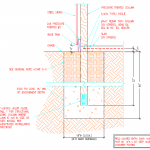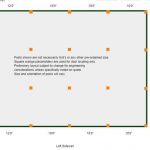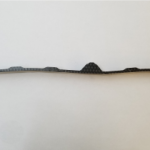Let’s finish off the week with one more day of Ask the Pole Barn Guru. Today Mike takes on reader questions about connection with a continuous foundation, benefits of 10′ or 12′ column spacing, and replacing inside foam closures.
DEAR POLE BARN GURU: Hello. We are located in Ohio. We would like to build a 24×40 pole building. Zoning says it needs to be attached per their rules so we plan to attach with a simple fabric awning to meet zoning. The county says we need a continuous foundation if it is considered attached. Stupid right? The only thing touching both building will be a fabric awning. I have been told we can have an engineered foundation, or a 6″ by 38″ deep concrete wall poured, wood foundation or a traditional block foundation. Where would I begin to find details for an engineered foundation? I am struggling finding the info and where to start. RALPH in POLAND
 DEAR RALPH: In a typical fully engineered post frame (pole) building isolated columns embedded into your ground would be complying and meet Building Code requirements. We would like to see your jurisdiction’s written requirement for mandating a continuous foundation, as often times these ‘requirements’ are just one person’s own feelings of how things should be done, rather than having an actual basis.
DEAR RALPH: In a typical fully engineered post frame (pole) building isolated columns embedded into your ground would be complying and meet Building Code requirements. We would like to see your jurisdiction’s written requirement for mandating a continuous foundation, as often times these ‘requirements’ are just one person’s own feelings of how things should be done, rather than having an actual basis.
Should this indeed be an approved statute, we can have your new building engineered with your continuous foundation of choice. One of our Building Designers will be reaching out to you to discuss further, or dial 1.866.200.9657 for immediate service.
DEAR POLE BARN GURU: Are there any benefits going with 10′ centers over 12′ centers? I was thinking about going with 10′ centers because in my mind it seems like that would be a stronger building and would have less purlin sag over the years but rather go with 12′ centers to gain more parking space for a leanto? Any recommendations? Thanks BRIAN in PARRISH
 DEAR BRIAN: Regardless of spacing of columns or trusses, a fully engineered post frame building will be designed to meet or exceed a specified set of wind design criteria – speed and exposure. You are better served to increase design wind sped, so your entire buildings is capable of supporting higher loads, than to merely move columns closer together. Provided Code required deflection limitations have been properly engineered for, any purlin sag, over time, should be relatively imperceptible.
DEAR BRIAN: Regardless of spacing of columns or trusses, a fully engineered post frame building will be designed to meet or exceed a specified set of wind design criteria – speed and exposure. You are better served to increase design wind sped, so your entire buildings is capable of supporting higher loads, than to merely move columns closer together. Provided Code required deflection limitations have been properly engineered for, any purlin sag, over time, should be relatively imperceptible.
DEAR POLE BARN GURU: Greetings, My metal roof is 15 years old and the inside foam closures have deteriorated. 1. Are they necessary, and 2. if so, how does one replace them?
I hate to remove the screws along the eaves (or maybe even more screws farther up each panel), but see no other way to get replacement closures under the metal panels.
I’d appreciate any advice
Thanks SHERRY in RIO RANCHO
 DEAR SHERRY: Properly manufactured inside closure strips are UV resistant and should outlive your building’s steel roofing. Personally, I find them essential, as without them small flying critters have a clear path to enter your building. In order to replace them, you will have to remove screws along your eave line. Once remains of old closures are removed, new ones can be put in place. Old screws should be replaced by both larger diameter and longer screws, to maintain integrity of connections and prevent leaks.
DEAR SHERRY: Properly manufactured inside closure strips are UV resistant and should outlive your building’s steel roofing. Personally, I find them essential, as without them small flying critters have a clear path to enter your building. In order to replace them, you will have to remove screws along your eave line. Once remains of old closures are removed, new ones can be put in place. Old screws should be replaced by both larger diameter and longer screws, to maintain integrity of connections and prevent leaks.
For extended reading on Inside Closures https://www.hansenpolebuildings.com/2015/12/the-lowly-inside-closure/






